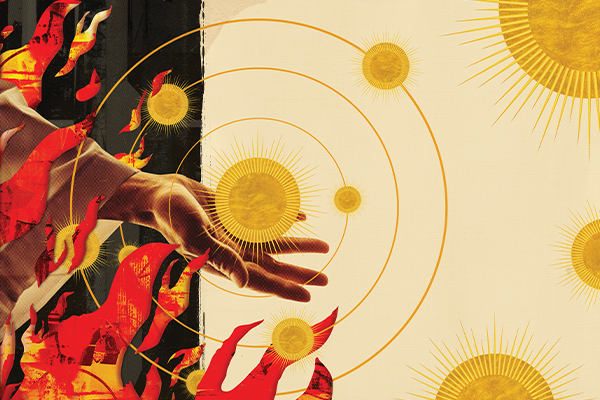A CENTURY AGO, the baseball-player-turned-evangelical-revivalist Billy Sunday preached a gospel supercharged by conspiracy theory and nationalism. He spoke against the backdrop of World War I to masses seized by national security anxiety directed at immigrant communities. Deploying a message made urgent and relevant by its conspiratorial frame, Sunday preached, “They call us the ‘melting pot.’ Then it’s up to us to skim off the slag that won’t melt into Americanism and throw it into hell or somewhere else.”
Hellish rhetoric has a long history in the United States for animating theological paranoia in service of supremacist political power. It’s also been part and parcel of American evangelicalism.
Like many kids growing up in evangelical culture in the 1990s, I was extremely familiar with hell. Popular preaching led with hell before it ever spoke of heaven. It described a place of terror reserved for the unbelieving, who always happened to be from the wrong political party or country. In those days, evangelical churches hosted so-called hell houses to “scare straight” teenagers who strayed from a very narrow moral code. My own church did annual dramas depicting people in hell. I prayed the “Sinner’s Prayer” more times than I could count, hoping I really meant it enough to save me for good. If you were to ask me then: “Do you believe in hell?” I would have said “Of course! I’m a Christian!” Belief in hell went hand in hand with belief in Jesus.
My faith today requires me to dismantle the understanding of hell I received as a child and the cultural use of hell popular today in the rise of Christian nationalism. Hell, in the Trump era, is a rogue theological element, unmoored from the Christian story. When Donald Trump says, “I want to make the country great again. This country is a hellhole,” he casts himself, theologically, in the role of Christ, dispensing judgment on who is good and who is bad.
Trump wields diabolical power to throw people to political hells — and that’s what he’s doing. This isn’t new. Poet Langston Hughes wrote prophetically in 1936, “Fascism is a new name for that kind of terror the Negro has always faced in America.”
In this stream of prophetic thought, we are roused to consider our own responsibility today. We cannot look away from the political hells rising up around us, including indiscriminate ICE raids at churches; repurposing the Guantanamo Bay detention camp to hold migrants; freezing funding for critical family services and health programs in the U.S. and around the world; dispossessing hundreds of thousands of civil servants from their livelihood; and blocking asylum access for those in fear for their lives — all creating indescribable suffering for those who don’t fit a very narrow white supremacist or libertarian agenda.
Read the Full Article

